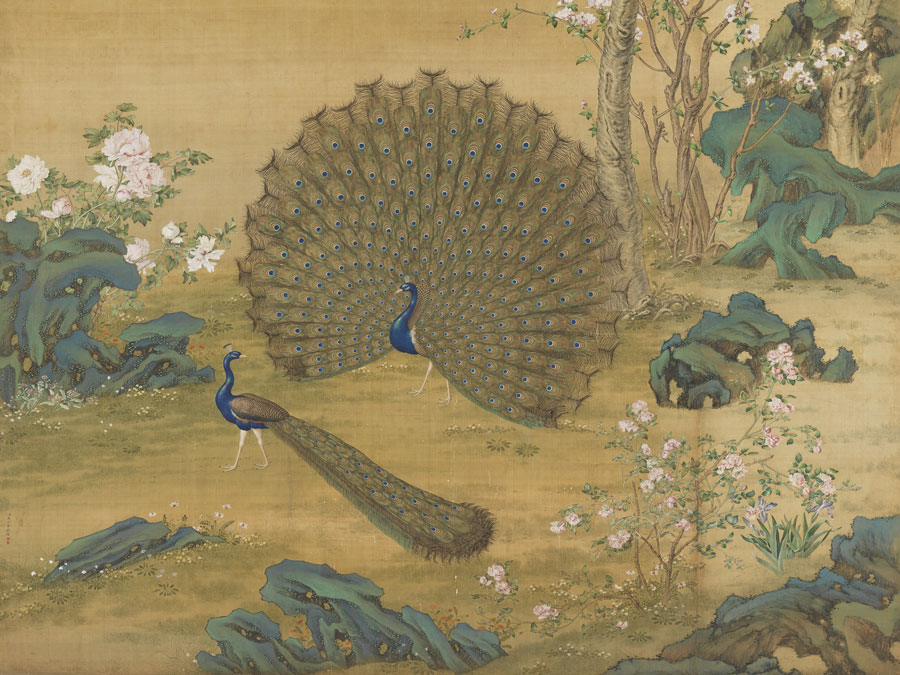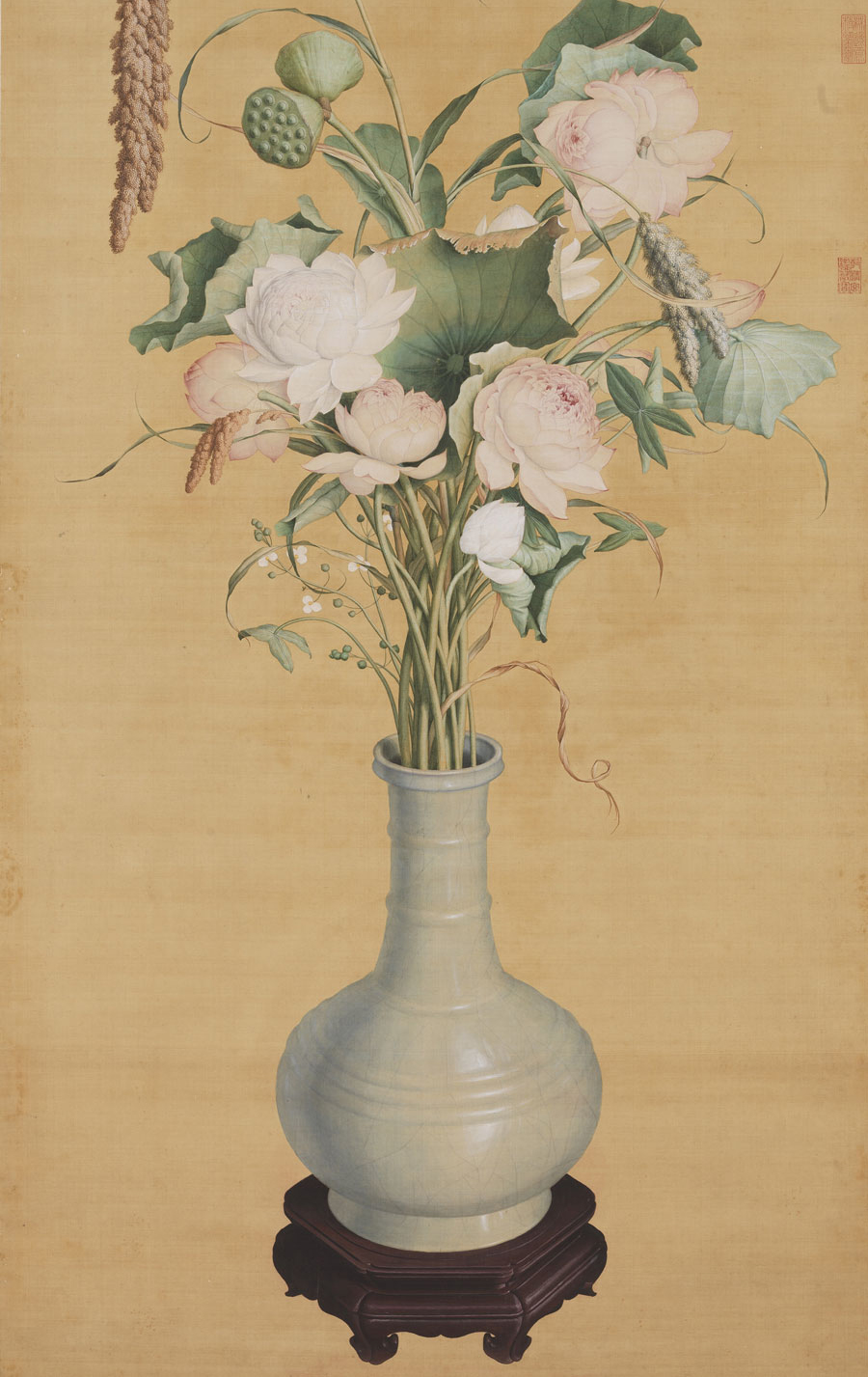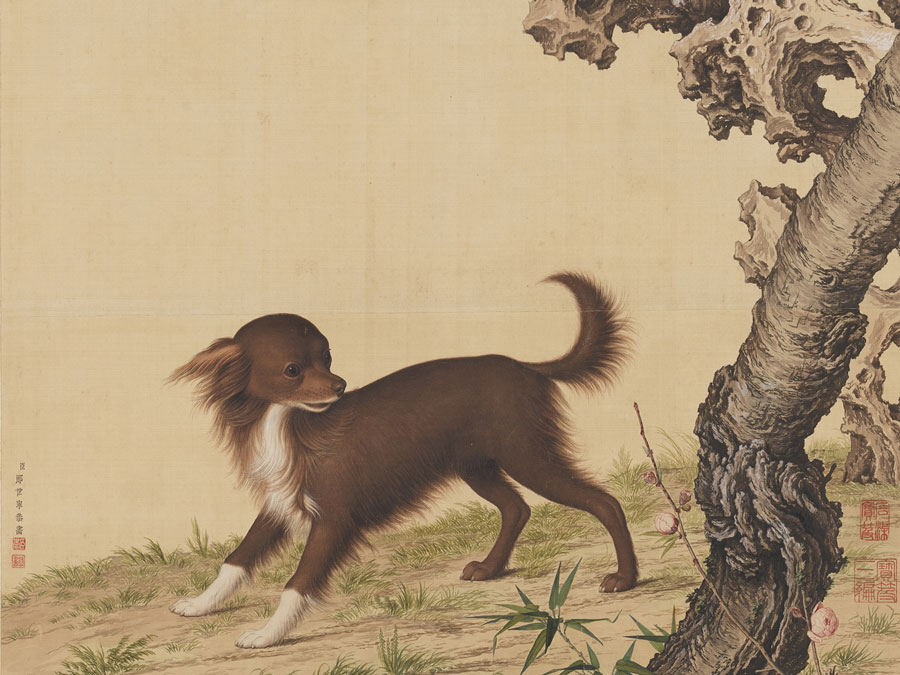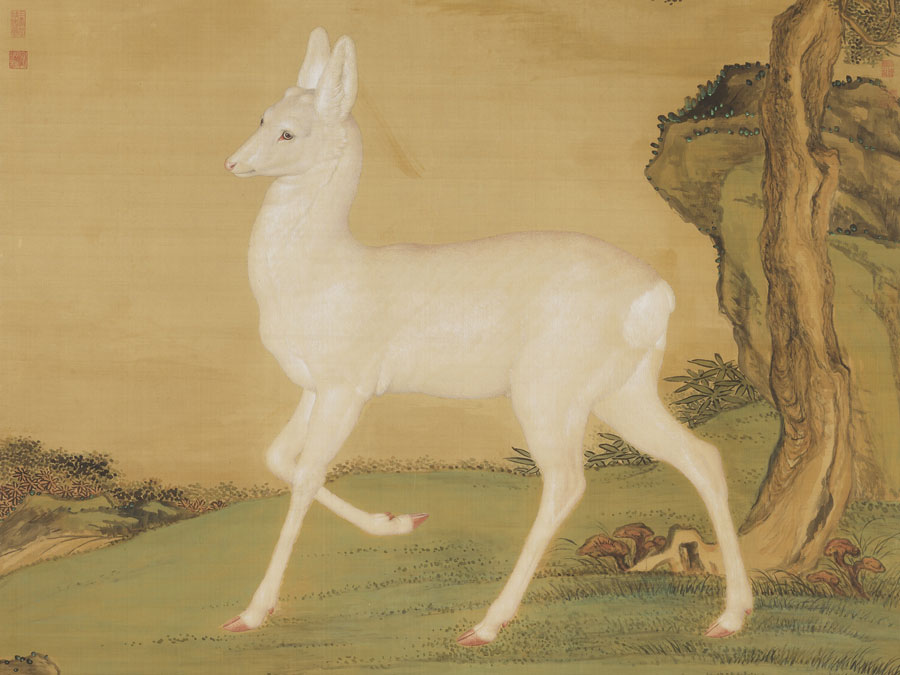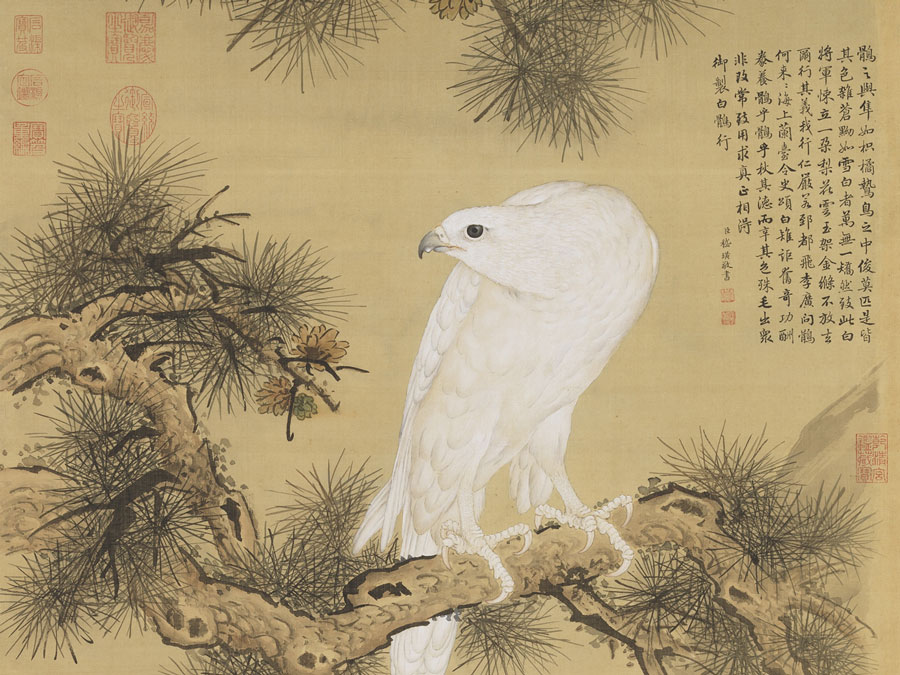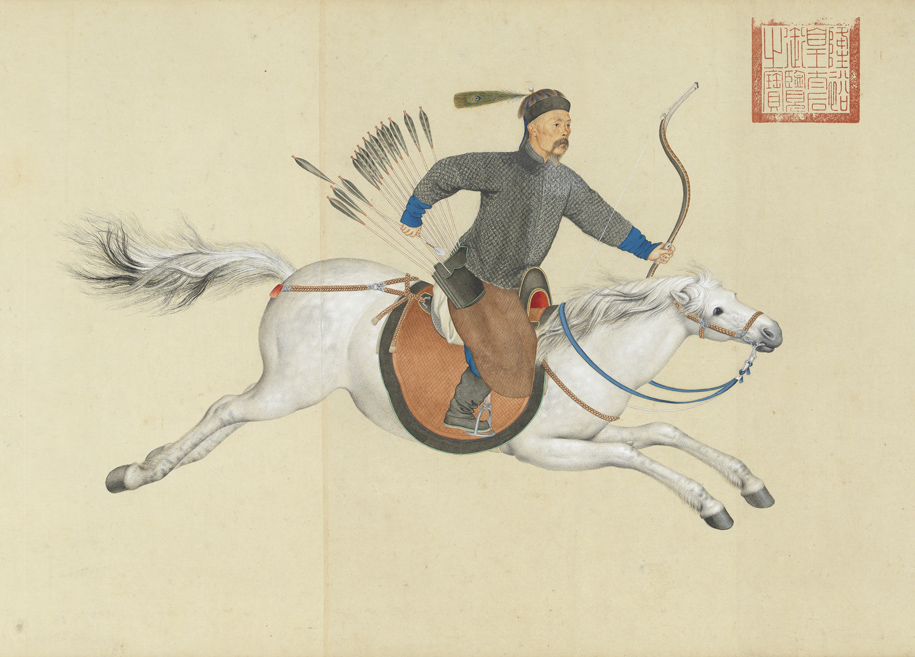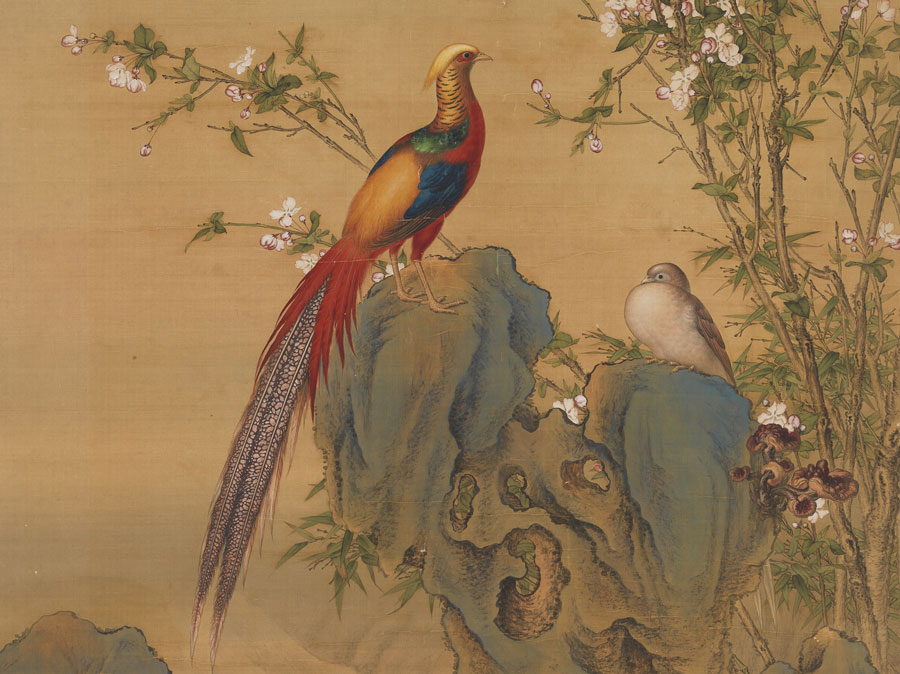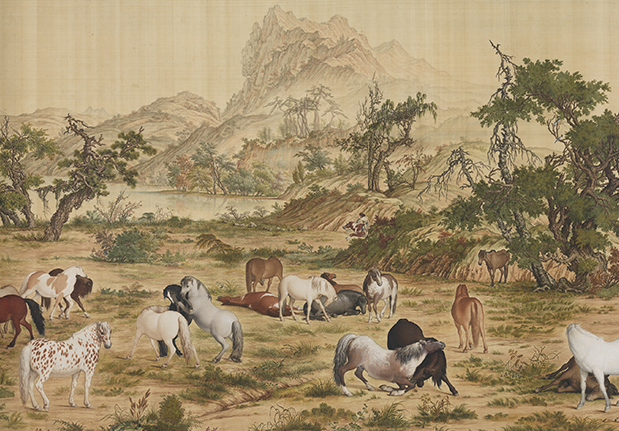Peacock Spreading Its Tail Feathers
- Lang Shining (Giuseppe Castiglione, 1688-1766),Qing dynasty
- 328 × 282 cm
The male peafowl, or peacock, is renowned for its circular display of long and opulent tail feathers, which can reach several feet in length over five years. The feathers are usually kept folded behind its body, but when expanded for display, they shine with iridescent beauty and dazzling "eye" patterns. This painting is a scene in a palatial garden designed with "blue-and-green" rocks as well as magnolia, peony, and cherry apple blossoms, further conveying the traditional auspicious idea of "wealth and nobility in halls of jade."
umul in the western regions began presenting peacocks as tribute to the Qing court starting from the reign of the Kangxi emperor. Appearing on this painting is a poem "Peacock Spreading Its Feathers" from the imperial brush of Qianlong dated to the sixth lunar month of the "wuyin" year (1758). A record from the Ruyi Hall section of the imperial workshop archives from that same year states, "Fourth month, 27th day: Palace Eunuch Hu Shijie conveyed the order that Lang Shining (Giuseppe Castiglione) and Jin Tingbiao were to do a large painting for the west wall of the antechamber to the Shuanghe ('Two-Crane') Study." The Qianlong emperor's instructions explicitly call for Castiglione to do the birds and vegetation, while Jin Tingbiao (?-1767) was to depict the garden rocks, making this a masterpiece of Sino-Western "cooperative painting."
Gathering of Auspicious Signs
- Lang Shining (Giuseppe Castiglione), Qing Dynasty
- Hanging scroll, ink and colors on silk
- 173 × 86.1 cm
In this painting is a celadon vase with an arrangement of auspicious plants such as dual-blossom lotuses and stalks of millet with two ears of grain, plants that have been used in painting since the Song and Yuan dynasties to symbolize sagacious rule. Giuseppe Castiglione signed his name in Chinese with the "Song-script" style of Qing court publications and included a date equivalent to 1723, the first year of the Yongzheng emperor's reign, making it his earliest dated work. An elevated point of view has been taken, allowing the viewer to peer into the neck of the vessel. Castiglione also used white pigment to highlight the shine on the glaze, enhancing the volumetric effect of this porcelain vase. As for the plants, Castiglione excelled at rendering gradated areas of color to express three-dimensionality and shading with a single source of light. The coloring overall is exceptionally refined, making the motifs appear as if radiating with brightness. The painting is a masterful example of how Castiglione translated Chinese subject matter using Western techniques. The vase shown here also appears similar to an imitation Ru-ware celadon with linear patterns in the collection of the National Palace Museum.
Long-haired Dog Beneath Blossoms
- Lang Shining (Giuseppe Castiglione, 1688-1766), Qing dynasty
- Hanging scroll, ink and colors on silk
- 123.2 × 61.9 cm
This painting depicts a small reddish-brown dog by a lake rock and peach blossoms in a garden setting. The blossoms come from an old peach tree growing in the lower right corner and extending out of the composition. Even a few new sprigs with blossoms emerge from the dense and gnarled roots, suggesting that the tree is still full of life. In the background is a large decorative lake rock, its convoluted form complementing that of the old tree. The rendering of the little dog is quite precise and endearing, a sense of motion inherent in it despite the stillness. In mid-step, its attention appears to have been caught by something outside the composition, making it stop to look back. Giuseppe Castiglione used extraordinary refinement and realistic techniques to portray the animal, conveying not only its three-dimensionality but also the luster of its hair. Capturing both the subtleties of formal likeness and inner spirit, the latter became an especially important criterion for determining the success of an animal painting. This work is undated, but according to Qing court archives, Castiglione made alterations in the second lunar month of Yongzheng's fifth year (1727) to a painting of a small "date-red" dog, most likely referring to the one here.
Auspicious Roe Deer
- Lang Shining (Giuseppe Castiglione, 1688-1766), Qing dynasty
- Hanging scroll, ink and colors on silk
- 216.2 × 144.6 cm
In the autumn of 1751, the Qianlong emperor accompanied Empress Dowager Chongqing on a tour of the summer mountain retreat. Qianlong also traveled to the Mulan hunting grounds, where he was entertained to a banquet by Mongolian nobility. The Mongol Taiyiji Bilig-un dalai presented a roe deer as an offering, its fur as white as snow and eyes sparkling red. According to Ge Hong's (283-343) Baopuzi, the deer has a lifespan of a thousand years, turning white after reaching the age of 500. In this painting, the white roe deer has large ears and eyes, a long neck, and a short tail, serving as a symbol of good fortune and nobility as well. The year 1751 also happened to be the Empress Dowager's sixtieth birthday, a major event in traditional Chinese life, so the Qianlong emperor ordered Giuseppe Castiglione to do this painting and composed "Poetry on an Auspicious Deer" to bless his mother for a long life. Castiglione painted the animal, while the rocks, slope, mahogany, and spirit fungus were added by another court artist, Yao Wenhan (fl. ca. 1742-1789).
White Bird of Prey
- Lang Shining (Giuseppe Castiglione, 1688-1766), Qing dynasty
- Hanging scroll, ink and colors on silk
- 123.8 × 65.3 cm
The branch of an old pine tree extends across the composition with a white bird of prey (falcon) perched on it, a cascade descending into the valley behind. The falcon with its short flat head peers out, its eyes sparkling black. It also has a pointed beak and muscular legs with sharp talons. The ruling Manchu at the Qing court often received birds of prey as tribute, reflecting the common interests and heritage they shared with northern nomadic peoples. In the sixteenth year of the Qianlong emperor's reign (1751), the high court official Fuheng (1720-1770) presented this white bird of prey as tribute, and Giuseppe Castiglione was ordered to paint it from life, the pine tree and landscape with a waterfall added by another court artist. The compact size of the falcon makes it agile in flight, and known for its ferocity, it often served as a symbol of courage and victory. The Grand Academician Ji Huang (1711-1794) transcribed "Imperially Produced Song on a White Bird of Prey," respectfully referring to the falcon as a "White General."
Macang Lays Low the Enemy
- Lang Shining (Giuseppe Castiglione), Qing Dynasty
- Hand scroll , ink and colors on paper
- 38.4 × 285.9cm
Macang was one of the meritorious officials in the Qing court's pacification of rebellious Dzungar tribes. In the Battle of Qurman, Macang penetrated enemy ranks and laid low the enemy with his bow and arrow. Although later injured, he continued to do battle. To commemorate his bravery, the Qianlong emperor ordered Giuseppe Castiglione to do this handscroll painting, to which the emperor added a long inscription to eulogize the event. In the painting, Macang has already shot the enemy, who slumps over on the horse with an arrow in his back. Macang had previously thrown his lance but missed, using his bow and arrow instead. The horses appear with legs aloft to indicate the speed of their gallop, and the background of the painting is otherwise blank to heighten the tension of the scene. This work on paper has a slightly different technique. Not only featuring washes, it also has fine lines and texturing for the faces, Macang's eyes being especially spirited to portray his intense concentration. Macang is unrecorded in the draft biographies of Qing historical figures, but this painting of him by Castiglione commemorates his important contribution to the Qing court.
Golden Pheasants in Spring
- Lang Shining (Giuseppe Castiglione, 1688-1766), Qing dynasty
- Hanging scroll, ink and colors on silk
- 169.2 × 95.2cm
This scroll portrays Chinese flowering crab apple in full bloom with a pair of golden pheasants (one male and the other female) perched on garden lake rocks by flowing water. The flowers form a brocade with exotic birds, auspicious spirit fungus, and bamboo all being metaphors to convey good fortune and longevity. The golden pheasant cock is shown with its bright and beautiful plumage, Giuseppe Castiglione using white lines to highlight the shine on its feathers for rich luster but without shadows for its form. The crab apple blossoms and spirit fungus are painstakingly colored with variations of light and dark as well. The landscape is rendered more with the Chinese use of brush and ink, but with exceptional attention paid to the detail. Even overlapping crab apple blossoms and bamboo in the background can be distinguished through the holes in the rock. The composition of this scroll is also more complex than that seen in "Myriad Longevity in an Everlasting Spring," indicating that the landscape is no longer merely a background for plants or animals.
One Hundred Horses
This handscroll, completed in 1728, depicts a hundred steeds in various poses within a horizontally stretching landscape to create a majestic scene of pasturing. The horizon line for the landscape is maintained at a two-thirds height throughout, creating for a complete and contiguous sense of space across the surface of the painting and the scenery. The trees and other motifs are also shown in correct proportion to suggest a spatial effect of level distance. The technique in the painting differs from that of traditional Chinese art, with the artist, Giuseppe Castiglione, utilizing areas of light and dark colors for the forms to suggest their volumetric quality and to express a sense of light and shadow as well. As for the horses, though their forms are outlined with lines, they are mostly modeled with areas of color. Castiglione, however, consciously subdued the shadows for the forms to preserve their solidity but without creating a dramatic contrast between light and dark. This work can be seen as Castiglione's way of actively integrating the qualities of two disparate painting traditions.

